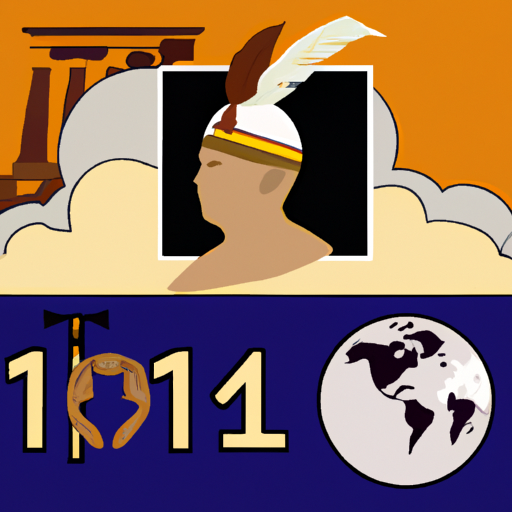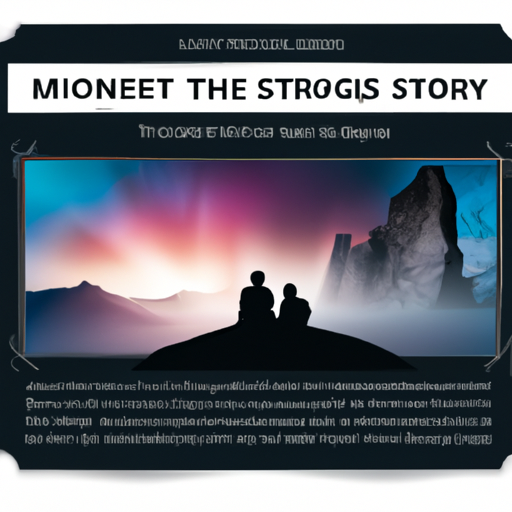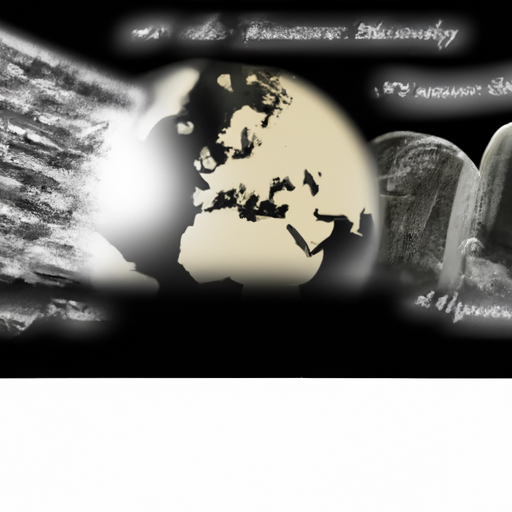History of the 7 Sumerian Gods
Unearth the antiquity of Sumer and discover the deities that held dominion over the region! Delve into a past shrouded in mystery and uncover the mysterious seven who reigned supreme. Uncover their secrets and learn more about this ancient civilization!

Mysteries abound in the ancient land of Sumer, located in what is now Iraq, dating back to the 4th millennium BCE. A complex pantheon of gods and goddesses held sway over the people, with seven deities reigning supreme.
Anu, the sky god, wielded power and authority; Enlil, god of wind and air, controlled nature; Ninhursag was mother goddess of fertility and growth; Nanna represented wisdom as moon god; Utu stood for justice as sun god; Inanna was goddess of love and war; and Enki was water god and magician.
These seven gods had their hands in all aspects of life in Sumer: from agriculture to law-making to trade. To this day, their legacy lives on through art, literature, and religion – a testament to their enduring influence. So if you’re curious about this ancient civilization’s captivating history – its gods and goddesses – then take your first steps here!
.
Introduction

Mystical and enigmatic, a pantheon of gods from long ago is remembered in the annals of history. From around 4,000 BC, the ancient Sumerians worshipped a group of seven deities who were believed to preside over aspects such as fertility, war, justice and death. Anu, Enlil, Ninhursag, Nanna-Sin, Utu/Shamash, Inanna/Ishtar and Ea/Enki were these powerful entities whose stories have been told for generations. Even today their legacy still lingers in our culture.
– The Historical Origins of the Sumerian Gods
Enigmatic and mysterious, the gods of Sumer have captivated humanity since ancient times. It is believed that around 4500 B.C., the first people to revere them were the Sumerians in Mesopotamia, who believed these deities had created the world and all its inhabitants, and thus sought their protection, fertility, and prosperity. Over time, this pantheon expanded to include over two thousand gods with various roles and powers.
These gods were divided into three main categories: Anunnaki (“great gods”), Igigi (lesser gods), and humans who served them. The Anunnaki were led by Anu, sky god; Enlil, storm god; and Inanna, goddess of love and war – they controlled weather patterns, crop yields, fertility rates, warfare, among other matters. The Igigi were minor gods tasked with daily duties such as farming or smithing tools.
The Sumerian religion was polytheistic; that is to say it acknowledged multiple gods rather than one supreme being. This belief system was passed down through generations via oral tradition until it was eventually recorded on clay tablets around 3000 B.C., forming our modern understanding of Sumerian religion and mythology.
The historical origins of these gods offer an insight into how people viewed their place in this world thousands of years ago – a deep reverence for their deities which shaped their culture for centuries to come.
– Exploring the Mythology Behind the Sumerian Gods
The gods of Sumer have long been a source of fascination, and delving into the mythology behind these deities can be an enlightening journey. To comprehend their history, it is essential to investigate their roots in ancient Mesopotamian religion. The Sumerians are thought to be some of the first civilizations of the old world, and their pantheon of gods was similarly influential.
The Sumerian gods were responsible for different aspects of life in Mesopotamia, such as combat and fertility. Anu, the god of sky and father of all other gods, was chief among them. Other prominent figures included Enlil, god of wind and storm; Ninhursag, goddess of fertility; Utu, god of justice; Inanna, goddess of love; Nanna-Sin, god of moon; and Enki, god of water. Every deity had special abilities that were utilized to shape the lives and fortunes of those living in ancient Mesopotamia.
Apart from having individual roles within their pantheon, each Sumerian god also embodied certain qualities that could be seen in everyday life. For instance, Anu stood for justice while Enki represented wisdom and knowledge. Similarly, Ninhursag was linked with fertility while Nanna-Sin symbolized time and destiny. By understanding these features connected with each deity, it is possible to gain insight into how the Sumerians viewed their world around them.
Investigating the mythology behind the Sumerian gods can provide an invaluable peek into one of humanity’s earliest civilizations. By studying their history and beliefs we can gain a greater comprehension not only about our past but also about ourselves today.
– The Significance of the Sumerian Gods in Ancient History
Mystical and awe-inspiring, the Sumerian gods were a powerful force in ancient history. Believed to be responsible for all aspects of life, from fertility and harvest to justice and warfare, these deities were venerated by the Sumerians who lived in Mesopotamia between 4500 BC and 539 BC.
Anu was the most important god, seen as a wise ruler and protector of his people. Other major gods included Enlil (air), Ninhursag (fertility), Utu (sun) and Inanna (love). Each had its own temple where they could be worshipped.
Rituals and offerings were made to appease the gods, with hopes that they would bring good fortune or heal land affected by drought or disease. The influence of these deities extended beyond religion; laws were said to have been inspired by them while art depicted scenes from mythology involving them. This helped spread knowledge about them throughout Mesopotamia as well as other parts of the ancient world.
Although their power eventually faded away with time passing by, it is clear that the Sumerian gods left an indelible mark on ancient history.
– How the Worship of the Sumerian Gods Evolved Over Time
The veneration of the Sumerian gods, one of the oldest known spiritual practices in existence, dates back to circa 4000 BC. The Sumerians believed in a pantheon of deities who had control over all aspects of life, from fertility and agriculture to war and justice. As they interacted with other cultures and civilizations, their faith evolved, bringing about modifications in how they worshipped these gods.
At first, offerings were made to Inanna, Enlil, and Ninhursag in hopes that they would bring good luck and prosperity. Later on, gods from neighboring Mesopotamian cultures such as Babylon and Assyria were added to their roster – Marduk, Ishtar, and Shamash among them. This prompted a shift from merely appeasing the gods for material gain to an emphasis on living a righteous life that would please them; this is evidenced by some of the oldest surviving written records which lay out laws governing behavior and morality under threat of divine punishment if not followed.
Moreover, polytheism led to more organized forms of religion with temples built specifically for worshipping certain gods or goddesses instead of just making offerings at home or in public spaces. Priests acted as intermediaries between humans and deities who could offer advice on how best to appease them or ask favors on behalf of their people. Additionally, members of society began viewing themselves as chosen by certain deities or even claiming direct descent from them – a concept that would become increasingly popular until it became central to many religions today.
Evidently then, the worship of Sumerian gods changed drastically over time due to cultural interactions and shifts in moral values within society itself; it is an example of how dynamic faith can be even when rooted in ancient traditions like those found among the earliest civilizations in human history.
– Examining the Cultural Impact of the Sumerian Gods on Ancient History
The power of the Sumerian gods and goddesses, including Anu, Enlil, and Ninhursag, has been felt through the ages. From architecture to literature, their influence can be seen in many aspects of ancient history. Temples were crafted with intricate detail to honor them while statues depicting their figures were prominently placed within these structures. Laws created during this time may have been based on principles set forth by these deities, serving as a way for rulers to demonstrate loyalty.
Myths about the gods and goddesses helped explain natural phenomena and provided guidance on how one should live according to religious beliefs. Art from this era often featured scenes involving these deities or used symbols associated with them as a way to pay tribute. Pottery and jewelry pieces from this time period are especially known for featuring images related to the Sumerian gods.
It is clear that the Sumerian gods had a lasting impact on ancient history that still resonates today. Their legacy continues to shape our understanding of this era in myriad ways.
conclusion

Astonishingly, the Annunaki, or 7 Sumerian gods, have been a subject of great perplexity amongst historians. Awe-inspiringly, these deities are believed to have been responsible for the formation of mankind and the regulation of the universe. Anu, Enlil, Ninhursag, Enki, Nanna, Utu and Inanna were their names; they had an indescribable influence on Mesopotamian culture and religion. Historians still strive to comprehend this era in history by studying these gods.
.
Some questions with answers
Q1: Who were the 7 Sumerian gods?
A1: The 7 Sumerian gods were An, Enlil, Enki, Ninhursag, Nanna, Utu and Inanna.
Q2: What type of gods were the 7 Sumerian gods?
A2: The 7 Sumerian gods were polytheistic deities that represented various aspects of life such as fertility, war and justice.
Q3: Where did the 7 Sumerian gods originate from?
A3: The 7 Sumerian gods originated from Mesopotamian mythology in ancient Iraq.
Q4: When did the 7 Sumerian gods first appear in history?
A4: The 7 Sumerian gods first appeared in written records around 3000 BCE.
Q5: How did people worship the 7 Sumerian gods?
A5: People would offer prayers and sacrifices to the 7 Sumerian gods in temples or shrines. They also created artworks depicting them and wrote stories about their deeds.





